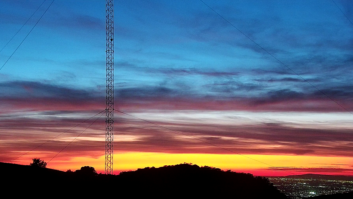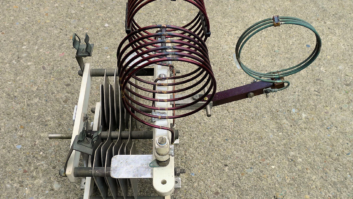This article originally appeared in TV Technology.

SIOUX FALLS, S.D. — The Prairie Aerial team didn’t intend to make a viral video, but their drone footage of a tech changing a light bulb on top of a 1,500-foot TV tower drew more than 1.8 million views on YouTube as well as the attention of the Federal Aviation Administration. (See “Dronecam Captures Tech Changing Bulb at 1,500 Feet.”)
The team used a DJI Phantom 2 modified for higher performance with Antigravity motors, which are more powerful than the stock motors, and balanced carbon-fiber props, a spokesman said. It is controlled with a Futaba T8FGS transmitter for extended flexibility and functions. The crew has five batteries and two chargers for the Phantom, “so we can fly all day,” the spokesman said.
The camera is a GoPro 3+Black also modified with a 5.4 mm rectilinear flat lens with IR filter. They fly it with a 3-stop Polar-pro ND filter. The gimbal is a Zenmuse H3-3D. No counter-balance for the weight of the ND filter is employed. The camera records at 2.7k, 30 fps ProTune on. First person view is a 5.8 GHz SD system, with dual diversity 9-inch HD monitor and goggles on the ground.
Todd Thorin is principal of Prairie Aerial. He fielded a few questions from TV Technology about the operation and the drone shoot.
TV TECHNOLOGY: What made you decide to start Prairie Aerial?
THORIN: Watching aerial footage just always got to me somehow, I just loved it and wanted to be able to shoot my own dramatic footage, it adds such a dimension to any storytelling by film/video. Maybe it’s because I always wanted to be an astronaut or a pilot, but my body wouldn’t allow it — I get motion sick pretty easy — so this makes it possible for me to fly. Starting the business is to be able to be one of those people who make a living doing what they love … not making a living yet, barely enough to keep the drone in the air, but I love it!
TV TECHNOLOGY: Did you experiment with several drone types and cameras before settling on the Phantom? Does flight control of these things vary widely?
THORIN: This is my first. I studied a great deal to determine what should be my first purchase. At the time I started, the only camera-carrying drones were pretty large — the large quad, hex and octocopters carrying a heavy DSLR camera or video camera. I was interested in getting production-quality video, so that was pretty much it, and they weren’t cheap. I couldn’t afford those machines. Then my videographer friend told me that the GoPros were really getting good, usable footage now. That brought the barrier to entry down into my range, and this coincided with the present explosion of small but very capable drones. I don’t have a wide range of experience flying larger copters to know the handling characteristics of the different types. I want to get one of those someday.
TV TECHNOLOGY: Are you a licensed pilot?
THORIN: I am not a licensed pilot. I do work with one to advise me of regulations relating to the NAS [National Airspace System] and “real” aircraft so I don’t run afoul of them, for example knowing the clearance around a broadcast tower where he would not be allowed to fly his aircraft, so that I felt justified in flying there safely.
TV TECHNOLOGY: You guys exceeded the Federal Aviation Administration’s rule prohibiting model aircraft flight above 400 feet. Are you concerned about being fined?
THORIN: The FAA has made contact with me. As I mentioned above, I felt justified in flying where I did because I was where I would not interfere with “real” aircraft — the spirit of the FAA’s recommendation (not a rule) to keep model aircraft under 400 feet. I just hoped that they would appreciate that I did my homework, so to speak, and not get me in trouble, if they even noticed at all. I didn’t really expect to become viral and catch the attention of the FAA but that became inevitable after 1.3 million hits in a week and all the media attention. I am now a member of a very small group of citizens who has actually received written notice to cease operations, meaning commercial operations. They did admit that the video is really cool though!
TV TECHNOLOGY: What applications do you anticipate for your business? There’s a lot of talk about agricultural applications, but what about with regard to towers? (Here’s one commenter said on the storyTV Technology did on drones around your video: “Too bad the drone couldn’t have just changed the light bulb and saved him the climb.”) Could this save tower crews a lot of time, risk and money, and in what ways?
THORIN: In the tower arena, there is much talk about climber safety. If a drone flight could reduce the number of climbs needed, or in other words, reduce worker exposure to the fall hazard, that would fulfill the OSHA policy to use “engineering controls” to mitigate hazards. This video proved that a preliminary inspection of a lighting system is possible that could save a trip up to the top of that TV antenna — that’s a win. Being able to have a look at a damaged or questionable structure before sending a man up might be another great drone usage. Actually performing work though a drone at height is probably a long ways down the road, but if I dropped that bulb and the drone could bring up another …
TV TECHNOLOGY:How are you handling your new YouTube stardom?
THORIN: Its a whirlwind at present, mind-boggling. I am handling my YouTube stardom by standing around in utter astonishment. Six months ago I was wondering how to get my name out to the locals, now our name is mentioned and our work is viewed around the globe and people are asking my expert opinion. It’s crazy and it will go as quickly as it came, I just hope to be able to get some useful, lasting benefit from the fame, and to help this amazing technology come into its own. Hopefully we are not just a one hit wonder, but that video will be a hard act to follow.












